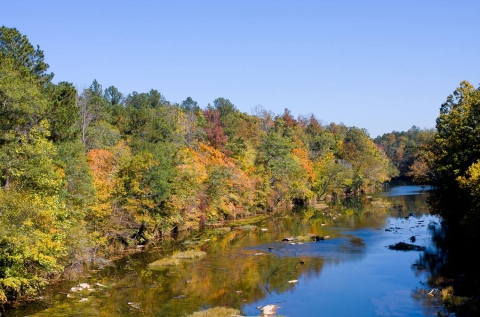About Us
Cahaba River National Wildlife Refuge was established September 25, 2002 for the purpose of protecting and managing a unique section of the Cahaba River and land adjacent to it. The refuge is home to five federally listed species including the Cahaba shiner, goldline darter, round rocksnail, and cylindrical lioplax snail. The refuge consists of 3,681 acres in Bibb County, with an approved acquisition boundary of 7,784 acres.
The Cahaba River itself stretches for almost 200 miles and is Alabama's longest free-flowing stream. The river currently supports 64 rare and imperiled plant and animal species, 13 of which are found nowhere else in the world. The entire length of the Cahaba River was designated, in 2004, as critical habitat for 2 federally listed freshwater fish species. The river has more fish species at 131 than any other river it's size in North America. Over seven miles of the Cahaba lie within the approved acquisition boundary. The rolling uplands surrounding the river are forested with mountain longleaf and loblolly pines. Mixed upland hardwood species line ravines and the river's edge.
The largest known stand of the imperiled shoals lily (known locally as the Cahaba lily) also occurs within the Refuge. During summer months, this beautiful plant blooms and people come from across the region to view this magnificent display of nature. There is even an annual Cahaba Lily Festival in late May that draws thousands of visitors to the area.
Our Mission
The purposes under which the refuge was established are as listed:
- Conserve, enhance, and restore the native aquatic and terrestrial community characteristics of the Cahaba River (including associated fish, wildlife, and plant species
- Conserve, enhance, and restore habitat to maintain and assist in the recovery of animals and plants that are listed under the Endangered Species Act of 1973
- Provide opportunities for compatible fish and wildlife-dependent recreation, ensure that hunting, fishing, wildlife observation, wildlife photography, and environmental education and interpretation are the priority general public uses of the refuge
- Encourage the use of volunteers and to facilitate partnerships among the United States Fish and Wildlife Service, local communities, conservation organizations, and other non-Federal entities to promote public awareness of the resources of the Cahaba River National Wildlife Refuge and the National Wildlife Refuge System and public participation in the conservation of those resources.
Other Facilities in this Complex
Cahaba River National Wildlife Refuge is managed as part of the Wheeler National Wildlife Refuge Complex.





